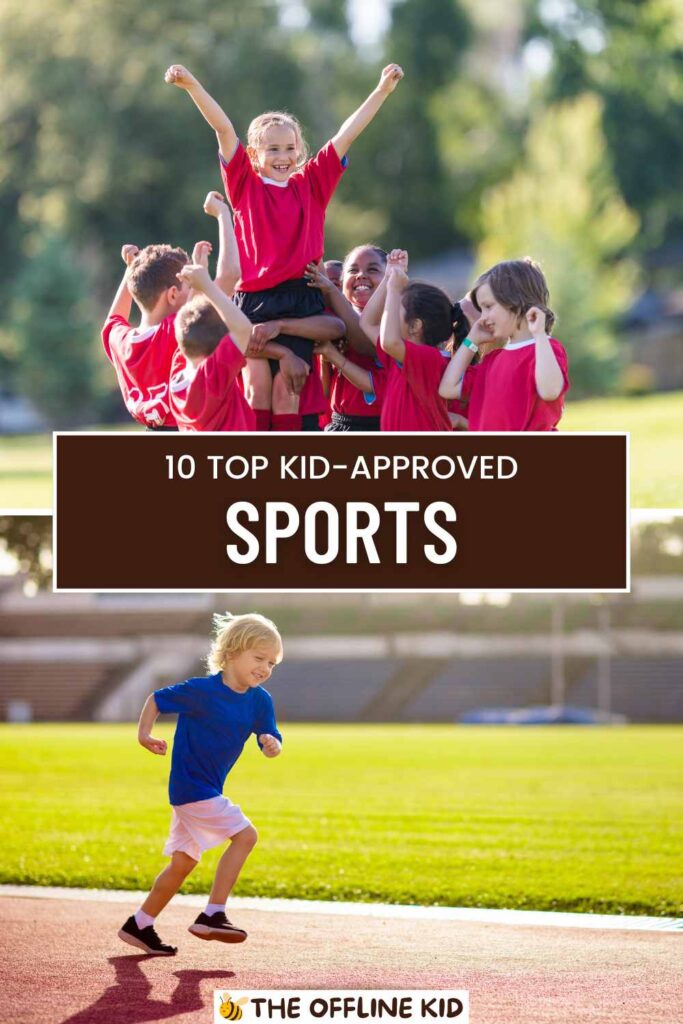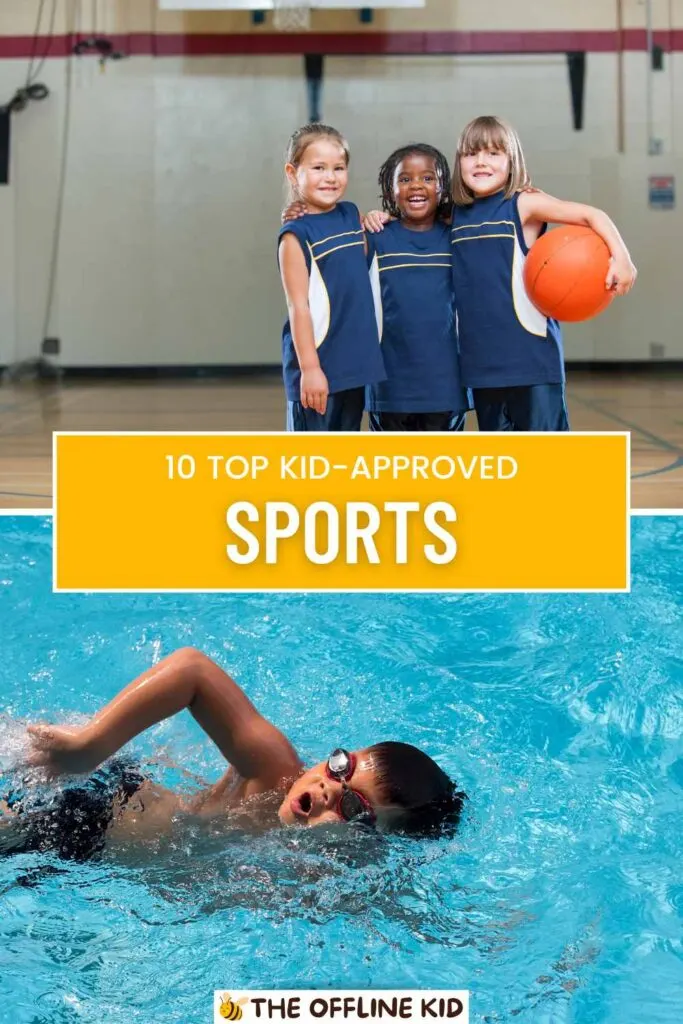Engaging in sports offers kids numerous benefits, from physical fitness to social skills and mental resilience.
This guide explores ten must-try sports for children, providing insights on how to get started and the unique advantages each sport offers.
Soccer
Soccer, also known as football in many countries, is the world’s most popular sport. It has a rich history dating back over 2,000 years to ancient civilizations.
Today, millions of children play soccer globally, making it a fantastic choice for young athletes.
Benefits
Physical Benefits:
- Endurance: Running up and down the field enhances cardiovascular health.
- Agility: Quick changes in direction improve balance and coordination.
- Strength: Kicking and defending build leg and core muscles.
Social Benefits:
- Teamwork: Soccer teaches kids how to work together to achieve a common goal.
- Communication: Effective communication is essential for successful play.
- Friendships: Being part of a team helps children make new friends and build social networks.
Getting Started
Basic Equipment Needed:
- Soccer Ball: The most crucial piece of equipment.
- Shin Guards: Essential for protecting the legs.
- Cleats: Specialized shoes for better traction on the field.
Finding Local Leagues or Clubs:
- Check community centers or local sports complexes.
- Schools often have teams or can recommend nearby clubs.
- Online directories and apps can help locate soccer programs.
Tips for Parents
Encouraging Practice and Participation:
- Positive Reinforcement: Celebrate achievements and effort, not just wins.
- Consistent Practice: Encourage regular practice to improve skills and confidence.
- Involvement: Attend games and practice sessions to show support.
Supporting Without Pressuring:
- Listen to Your Child: Understand their interests and motivations.
- Balance: Ensure a healthy balance between sports, academics, and free time.
- Enjoy the Process: Focus on fun and development rather than just competition.
Soccer is an excellent sport for kids to start with due to its global popularity, the simplicity of the game, and the numerous benefits it offers.
Whether your child dreams of playing in the World Cup or simply enjoys kicking a ball around with friends, soccer is a fantastic way to stay active and build valuable life skills.
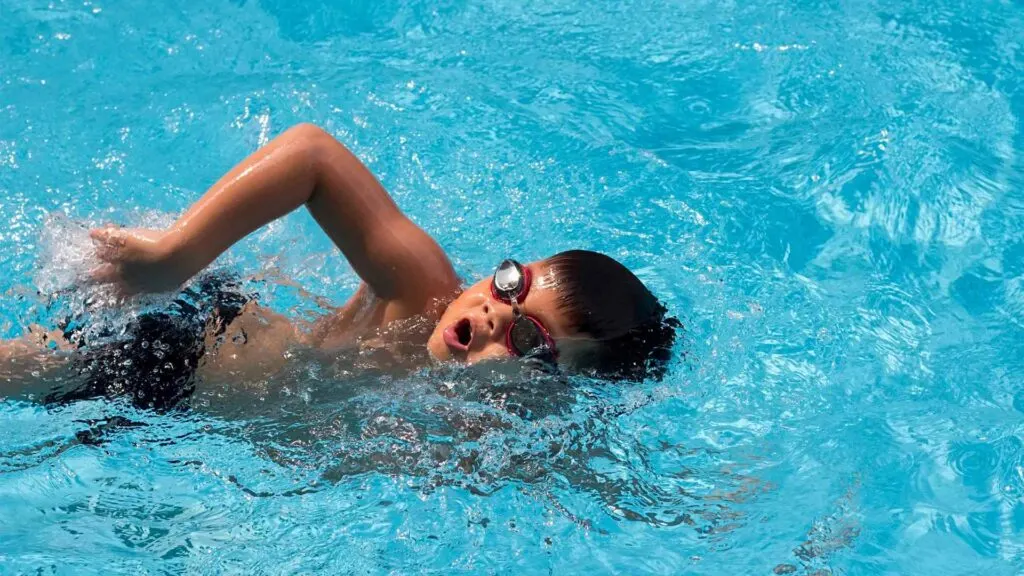
Swimming
Swimming is not only a popular competitive sport but also an essential life skill. Whether your child aims to compete or simply enjoys splashing around, swimming offers numerous benefits.
It’s a versatile activity that can be enjoyed year-round, indoors or outdoors, and is suitable for children of all ages.
Benefits
Physical Benefits:
- Full-Body Workout: Swimming engages nearly all muscle groups, promoting overall strength and endurance.
- Cardiovascular Health: Regular swimming improves heart and lung function.
- Low-Impact Exercise: The buoyancy of water reduces stress on joints, making it a safe option for kids.
Safety Benefits:
- Drowning Prevention: Learning to swim equips children with essential skills to stay safe in and around water.
- Water Confidence: Early exposure to swimming builds comfort and confidence in water environments.
Getting Started
Swimming Lessons:
- Choosing a Class: Look for certified instructors and small class sizes for personalized attention.
- Public Pools: Many community centers and schools offer affordable lessons.
- Private Lessons: One-on-one instruction can be more flexible and tailored to your child’s needs.
Necessary Gear:
- Swimsuits: Comfortable and suitable for frequent use.
- Goggles: Protect eyes from chlorine and improve underwater vision.
- Swim Cap: Keeps hair out of the face and reduces drag in the water.
Tips for Parents
Encouraging Water Safety:
- Supervision: Always supervise your child around water, regardless of their swimming ability.
- Safety Rules: Teach children basic water safety rules, such as no running near the pool and not swimming alone.
Making Swimming Fun:
- Games and Activities: Incorporate fun games to keep practice sessions enjoyable.
- Positive Reinforcement: Celebrate milestones and progress, no matter how small.
- Family Swim Time: Make swimming a family activity to encourage regular practice and enjoyment.
Swimming is an invaluable skill that offers lifelong benefits. Whether your child is swimming for fun, fitness, or competition, it’s a sport that promotes physical health, safety, and enjoyment.
By starting early and encouraging regular practice, you can help your child develop a love for swimming that lasts a lifetime.
Basketball
Basketball is a dynamic and fast-paced sport with a rich history and a massive global following. It’s a versatile game that can be played indoors or outdoors, making it accessible year-round.
From school teams to community leagues, basketball offers numerous opportunities for kids to participate and excel.
Benefits
Physical Benefits:
- Speed and Agility: Quick movements and direction changes enhance agility and reflexes.
- Strength and Endurance: Dribbling, shooting, and defending build muscle strength and cardiovascular health.
- Hand-Eye Coordination: Skills like shooting and passing improve hand-eye coordination.
Mental Benefits:
- Strategic Thinking: Understanding plays and tactics fosters critical thinking and problem-solving skills.
- Quick Decision-Making: Fast-paced gameplay encourages rapid decision-making under pressure.
Getting Started
Basic Equipment Needed:
- Basketball: The most important piece of equipment.
- Hoop: Can be installed in a driveway or found at local parks and gyms.
- Appropriate Shoes: Basketball shoes provide the necessary support and traction.
Joining School Teams or Community Leagues:
- Schools often have teams that cater to various skill levels.
- Community centers and local gyms frequently host leagues and clinics.
- Online platforms can help find nearby teams and training programs.
Tips for Parents
Encouraging Regular Practice:
- Set Up a Hoop: Install a hoop at home for easy and regular practice.
- Routine: Establish a regular practice schedule to build skills consistently.
- Skill Drills: Incorporate fun drills that improve different aspects of the game.
Fostering a Love for the Game:
- Watch Games Together: Watching professional or local games can inspire and motivate your child.
- Support and Celebrate: Attend games, cheer them on, and celebrate their achievements and efforts.
- Keep It Fun: Emphasize enjoyment and personal growth over competition.
Basketball is a fantastic sport that combines physical fitness with mental agility. It’s an excellent choice for kids looking to stay active, develop new skills, and make friends.
With its blend of individual skill and team strategy, basketball provides a well-rounded experience that can benefit children both on and off the court.
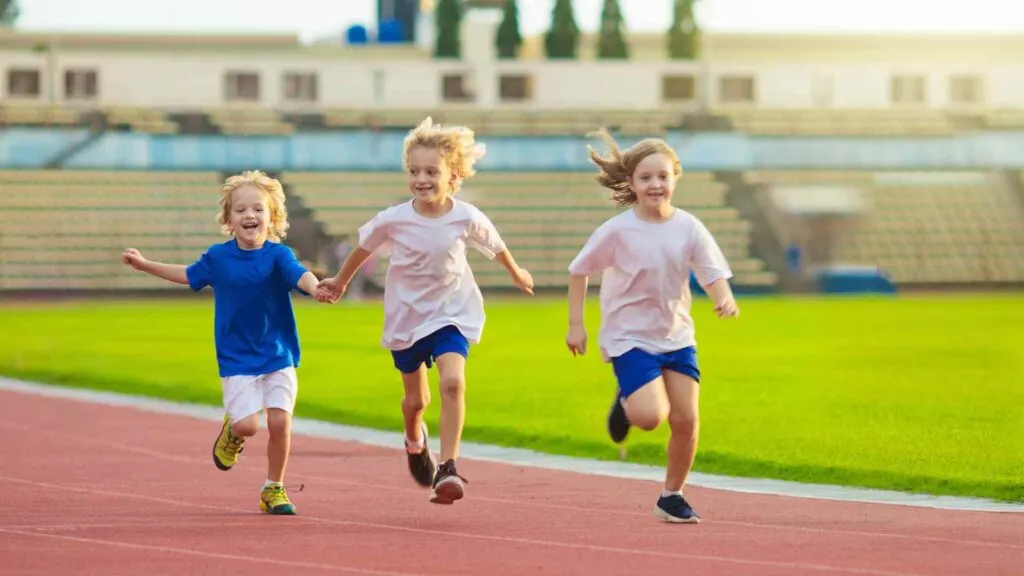
Gymnastics
Gymnastics is a sport that combines grace, strength, and flexibility. With its various disciplines like artistic, rhythmic, and trampolining, gymnastics offers a diverse range of activities that can cater to different interests and skill levels.
It’s a sport that not only builds physical prowess but also fosters discipline and confidence.
Benefits
Physical Benefits:
- Flexibility: Regular stretching and movements enhance flexibility.
- Strength: Gymnasts develop significant muscle strength, particularly in the upper body and core.
- Balance and Coordination: Complex routines improve balance and overall coordination.
Mental Benefits:
- Discipline: The structured nature of training instills a sense of discipline and commitment.
- Focus: Learning and perfecting routines enhance concentration and focus.
- Self-Confidence: Achieving goals and mastering skills boosts self-esteem and confidence.
Getting Started
Finding a Reputable Gym:
- Research: Look for gyms with certified coaches and a good reputation.
- Visit: Tour the facilities and meet the coaches to ensure a good fit.
- Trial Classes: Many gyms offer trial classes to see if your child enjoys gymnastics.
Necessary Gear:
- Leotards: Comfortable and suitable for training and competition.
- Mats: Essential for safety during practice.
- Hand Grips: For advanced gymnasts, to protect the hands during bar routines.
Tips for Parents
Supporting Through Training:
- Encouragement: Offer positive reinforcement and celebrate progress.
- Patience: Understand that gymnastics skills take time to develop.
- Involvement: Attend practices and competitions to show support.
Emphasizing Fun and Progress:
- Set Realistic Goals: Help your child set achievable goals to maintain motivation.
- Balance: Ensure a healthy balance between gymnastics, academics, and free time.
- Avoid Pressure: Encourage your child to enjoy the sport without feeling pressured to excel.
Gymnastics is a sport that offers a wide range of physical and mental benefits. It’s an excellent choice for kids who enjoy challenging themselves and mastering new skills.
By fostering a supportive and encouraging environment, parents can help their children thrive in gymnastics, building a foundation of fitness, discipline, and confidence that will serve them well in all areas of life.
Martial Arts
Martial arts encompass a wide variety of disciplines, including karate, taekwondo, judo, and Brazilian jiu-jitsu.
Each discipline offers unique techniques and philosophies, but all share common benefits such as physical fitness, mental discipline, and self-defense skills.
Martial arts are not just about fighting; they teach respect, patience, and perseverance.
Benefits
Physical Benefits:
- Strength and Agility: Martial arts training enhances muscle strength, agility, and coordination.
- Endurance: Regular practice improves cardiovascular health and stamina.
- Flexibility: Techniques and stretching exercises increase flexibility.
Mental Benefits:
- Discipline: The structured training and respect for instructors instill discipline.
- Confidence: Mastering techniques and progressing through ranks build self-esteem.
- Focus: Concentration on forms and movements enhances mental clarity and focus.
Getting Started
Choosing the Right Martial Art:
- Research: Learn about different martial arts to find one that matches your child’s interests and physical abilities.
- Trial Classes: Many dojos offer trial classes to help you decide.
- Instructor Qualifications: Look for certified and experienced instructors.
Finding a Good Dojo:
- Location: Choose a convenient location to ensure consistent attendance.
- Facilities: Ensure the dojo is clean, safe, and well-equipped.
- Community: A supportive and respectful community enhances the learning experience.
Tips for Parents
Encouraging Consistent Practice:
- Regular Schedule: Establish a consistent training schedule to build routine.
- Home Practice: Encourage practicing techniques at home to reinforce learning.
- Celebrate Progress: Acknowledge advancements and achievements, such as belt promotions.
Understanding the Grading and Belt System:
- Patience: Belt promotions can take time; encourage perseverance.
- Support: Attend belt ceremonies and competitions to show support.
- Balance: Ensure martial arts training complements, rather than competes with, academic and other activities.
Martial arts offer a holistic approach to physical and mental development. They teach valuable life skills such as self-discipline, respect, and resilience.
By choosing the right martial art and fostering a supportive environment, parents can help their children gain confidence, improve fitness, and develop a lifelong appreciation for the discipline and artistry of martial arts.
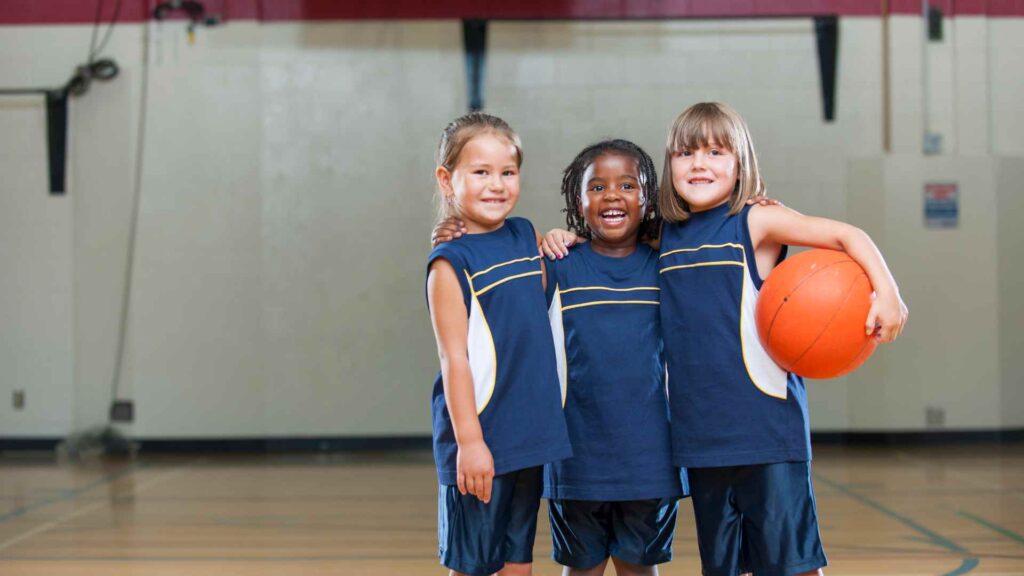
Baseball/Softball
Baseball and softball are beloved sports with rich traditions, especially in the United States. Both sports emphasize teamwork, strategy, and skill, providing kids with a fun and engaging way to stay active.
While baseball is typically played on a larger field and with a smaller ball, softball uses a larger ball and is often seen as a more accessible version for younger players.
Benefits
Physical Benefits:
- Coordination: Hitting, catching, and throwing enhance hand-eye coordination.
- Strength: Swinging a bat and throwing the ball build upper body strength.
- Endurance: Running bases and fielding improve cardiovascular health.
Social Benefits:
- Teamwork: Players must work together to succeed, fostering cooperation and communication.
- Discipline: Adhering to rules and maintaining focus during the game teaches discipline.
- Friendships: Being part of a team helps kids make new friends and build social networks.
Getting Started
Basic Equipment:
- Bat and Glove: Essential for hitting and fielding.
- Ball: Baseballs for baseball, softballs for softball.
- Protective Gear: Helmets, pads, and proper footwear to ensure safety.
Joining Local Leagues or School Teams:
- Community Leagues: Many towns have youth baseball and softball leagues.
- School Teams: Check if your child’s school has a team they can join.
- Camps and Clinics: Consider enrolling your child in a summer camp or clinic to build skills.
Tips for Parents
Encouraging Practice and Participation:
- Regular Practice: Encourage your child to practice regularly, both individually and with the team.
- Positive Reinforcement: Celebrate efforts and improvements, not just wins.
- Involvement: Attend games and practices to show your support and enthusiasm.
Supporting Skill Development:
- Skill Drills: Practice specific drills at home to enhance different aspects of the game.
- Balanced Approach: Ensure your child enjoys the game without feeling pressured to perform.
- Coach Interaction: Maintain open communication with coaches to understand your child’s progress and areas for improvement.
Baseball and softball are excellent sports for developing physical skills, teamwork, and discipline. They offer kids a chance to enjoy being part of a team while staying active and healthy.
With the right support and encouragement, children can thrive in these sports, gaining valuable experiences and lifelong memories.
Tennis
Tennis is a sport that combines physical prowess with mental agility. With a history dating back to the 12th century, it has evolved into a popular global sport enjoyed by millions.
Tennis can be played as a singles or doubles game, making it versatile and accessible for kids of all ages and skill levels.
Benefits
Physical Benefits:
- Agility: Quick movements and rapid direction changes enhance agility and reflexes.
- Strength: Serving and returning the ball build upper body and core strength.
- Cardiovascular Health: Continuous movement improves heart and lung function.
Mental Benefits:
- Strategic Thinking: Planning shots and anticipating opponents’ moves foster strategic thinking.
- Resilience: Handling wins and losses builds mental toughness and resilience.
- Focus: Concentrating on the game improves attention and focus.
Getting Started
Basic Equipment:
- Racket: Choose a lightweight, appropriately sized racket for your child.
- Tennis Balls: A supply of tennis balls for practice and play.
- Proper Shoes: Tennis-specific shoes provide the necessary support and traction.
Finding Lessons or Local Clubs:
- Tennis Clubs: Many clubs offer junior programs and lessons.
- Public Courts: Look for community courts that offer affordable or free access.
- Private Lessons: Consider hiring a private coach for personalized instruction.
Tips for Parents
Encouraging Regular Play and Practice:
- Consistency: Establish a regular practice schedule to build skills and confidence.
- Variety: Incorporate different drills and games to keep practice sessions engaging.
- Positive Environment: Create a supportive and positive environment for learning.
Making It Fun and Not Too Competitive:
- Focus on Fun: Emphasize enjoyment and personal improvement over competition.
- Family Play: Engage in family tennis matches to make the sport a fun activity.
- Tennis Camps: Enroll your child in tennis camps to learn in a fun and social setting.
Tennis is a sport that offers a perfect blend of physical activity and mental challenge. It helps kids develop important life skills such as strategic thinking, resilience, and focus.
By providing the right equipment, encouragement, and opportunities for practice, parents can help their children enjoy and excel in tennis, fostering a lifelong love for the game.
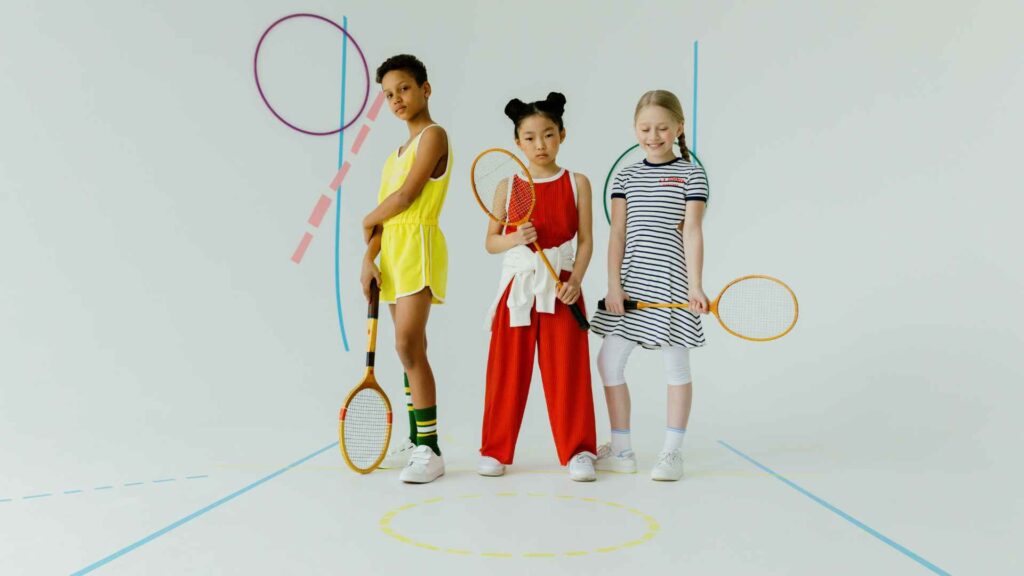
Track and Field
Track and field is a diverse sport that includes a variety of events such as running, jumping, and throwing. It is one of the oldest sports, tracing its origins to the ancient Olympic Games.
Track and field is highly versatile, offering something for every child, whether they enjoy sprinting, distance running, or field events.
Benefits
Physical Benefits:
- Overall Fitness: Track and field events enhance cardiovascular health, strength, and endurance.
- Speed and Agility: Sprinting and jumping improve speed and agility.
- Strength: Throwing events like shot put and discus build upper body and core strength.
Mental Benefits:
- Goal Setting: Training for specific events helps kids set and achieve personal goals.
- Perseverance: Overcoming challenges and pushing through tough workouts build perseverance.
- Self-Discipline: Regular training instills a sense of discipline and commitment.
Getting Started
Finding a Local Track Club or School Team:
- School Programs: Many schools offer track and field programs for various age groups.
- Community Clubs: Look for local track clubs that provide training and competition opportunities.
- Camps and Clinics: Enroll your child in summer camps or clinics to explore different events.
Basic Equipment:
- Running Shoes: Invest in a good pair of running shoes suitable for your child’s foot type and running style.
- Athletic Wear: Comfortable, breathable clothing appropriate for training and competition.
- Event-Specific Gear: Depending on the event, additional equipment like spikes, throwing implements, or jumping shoes may be needed.
Tips for Parents
Encouraging Participation in Different Events:
- Exploration: Encourage your child to try various events to find what they enjoy and excel at.
- Support: Attend meets and practices to show support and cheer them on.
- Balance: Ensure a healthy balance between training and rest to prevent burnout and injuries.
Emphasizing Personal Bests and Improvement:
- Focus on Progress: Celebrate personal improvements and achievements rather than just winning.
- Set Realistic Goals: Help your child set attainable goals to keep them motivated.
- Positive Reinforcement: Provide positive feedback and encouragement to build confidence.
Track and field offers a wide range of physical and mental benefits, making it an excellent choice for kids looking to stay active and challenge themselves.
By encouraging exploration and supporting their efforts, parents can help their children develop a passion for track and field that promotes a healthy lifestyle and a sense of accomplishment.
Volleyball
Volleyball is an exciting and fast-paced sport that can be played both indoors and on the beach. It involves two teams trying to score points by hitting a ball over a net into the opponent’s court.
Known for its engaging gameplay and emphasis on teamwork, volleyball is a fantastic sport for kids looking to stay active and make new friends.
Benefits
Physical Benefits:
- Agility and Coordination: Quick movements and precise ball handling improve agility and coordination.
- Strength: Jumping and spiking the ball build leg and upper body strength.
- Endurance: Continuous play and rallies enhance cardiovascular health and stamina.
Social Benefits:
- Teamwork: Volleyball requires constant communication and collaboration, fostering teamwork skills.
- Communication: Players learn to communicate effectively on the court.
- Camaraderie: Being part of a volleyball team helps kids form strong bonds and friendships.
Getting Started
Basic Equipment:
- Volleyball: A regulation-size volleyball for practice and play.
- Net: A volleyball net for setting up a court at home or in a community space.
- Knee Pads: Essential for protecting knees during dives and slides.
- Proper Shoes: Volleyball shoes with good grip and support.
Finding Local Leagues or School Teams:
- School Teams: Check if your child’s school offers a volleyball program.
- Community Centers: Many local gyms and community centers have leagues for various age groups.
- Camps and Clinics: Enroll your child in volleyball camps or clinics to build skills and meet other players.
Tips for Parents
Supporting Through Practice and Games:
- Practice Sessions: Encourage your child to practice regularly and join them for fun practice games.
- Attend Matches: Show your support by attending games and cheering them on.
- Skill Development: Help your child work on specific skills, such as serving or spiking, through drills and exercises.
Encouraging Teamwork and Sportsmanship:
- Positive Reinforcement: Celebrate teamwork and good sportsmanship, not just individual achievements.
- Team Activities: Encourage participation in team-building activities to strengthen bonds.
- Role Models: Highlight professional players or teams who exemplify great teamwork and sportsmanship.
Volleyball is a sport that combines physical activity with social interaction, making it a great choice for kids of all ages.
By providing the right equipment, encouragement, and opportunities for practice, parents can help their children enjoy and excel in volleyball, building valuable skills that will benefit them both on and off the court.
Cycling
Cycling is a versatile and enjoyable activity that can be done individually or in groups. It includes various styles such as road cycling, mountain biking, and BMX.
Cycling not only promotes physical fitness but also provides a sense of adventure and freedom. It’s an excellent way for kids to explore their surroundings while staying active.
Benefits
Physical Benefits:
- Cardiovascular Health: Regular cycling improves heart and lung function.
- Strength: Pedaling builds leg strength and endurance.
- Balance and Coordination: Maneuvering the bike enhances balance and overall coordination.
Mental Benefits:
- Independence: Cycling fosters a sense of independence and self-reliance.
- Stress Relief: Riding a bike can be a great way to relieve stress and enjoy the outdoors.
- Focus: Navigating different terrains and maintaining balance improve concentration and focus.
Getting Started
Choosing the Right Bike:
- Bike Type: Select the appropriate bike based on your child’s interests—road bike, mountain bike, or BMX.
- Size: Ensure the bike is the correct size for your child’s height and age.
- Safety Gear: Invest in a good-quality helmet, knee and elbow pads, and reflective clothing for visibility.
Finding Local Trails or Cycling Clubs:
- Community Trails: Explore local parks and trails suitable for beginners.
- Cycling Clubs: Many communities have clubs that organize group rides and events.
- Bike Shops: Local bike shops often have information about cycling groups and events.
Tips for Parents
Teaching Road Safety and Bike Maintenance:
- Road Safety: Educate your child on basic road safety rules, such as signaling and obeying traffic signs.
- Bike Maintenance: Teach basic bike maintenance, including checking tire pressure, adjusting brakes, and lubricating the chain.
- Supervision: Initially, supervise rides to ensure your child understands and practices safety measures.
Making Cycling a Family Activity:
- Family Rides: Organize family bike rides to make cycling a fun, shared experience.
- Explore New Routes: Discover new trails and paths together to keep things exciting.
- Set Goals: Encourage setting goals, such as riding a certain distance or participating in a local cycling event.
Cycling is a wonderful way for kids to stay active, explore their environment, and build lifelong skills. By choosing the right equipment, teaching safety, and encouraging regular rides, parents can help their children develop a love for cycling that promotes health and adventure.
